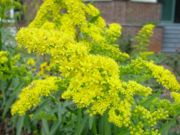Solidago speciosa - Showy Goldenrod
Scientific Name: Solidago speciosa
Common Name: Showy Goldenrod
Description: Hardy, herbaceous, North American summer-flowering perennial; forms tight clumps of red-tinged stems crowned with elongated, bright yellow flower clusters
Size: Grows 3 to 5 feet high in clumps; spreading roots
Cultural Information: Prefers full sun to light shade and well-drained sandy or loamy garden soil
USDA Zones: 2 through 9
Historical Notes: This showy member of the Aster family occurs naturally in prairies, meadows, and savannas from New England to Minnesota and Wyoming, and south to Georgia and Texas. Introduced to Western science in 1817 and admired by early American naturalists, showy goldenrod is considered one of the prettiest and best wildflowers for the butterfly flower garden or meadow. Its bright yellow flowers also attract hummingbirds and goldfinches and other small songbirds feed on its seeds.
William Cobbett, the English pamphleteer and farmer, wondered about goldenrod's ornamental use. He writes:
Nay, that accursed stinking thing, with a yellow flower, called the "Plain-Weed," which is the torment of the neighbouring farmer, has been, above all plants in this world, chosen as the most conspicuous ornament of the front of the King of England's grandest palace, that of Hampton Court, where, growing in a rich soil to the height of five or six feet, it, under the name "Golden Rod," nods over the whole length of the edge of a walk, three quarters of a mile long and, perhaps, thirty feet wide, the most magnificent, perhaps, in Europe.[1]
-Peggy Cornett, n.d.
Further Sources
- Dutton, Joan Parry. Plants of Colonial Williamsburg. Williamsburg: Colonial Williamsburg Foundation, 1979.
- Lady Bird Johnson Wildflower Center. Native Plant Information Network. "Solidago speciosa."
- Leighton, Ann. American Gardens in the Eighteenth Century. Amherst: University of Massachusetts Press, 1986.
- Thomas Jefferson Center for Historic Plants.
References
- ^ William Cobbett, The American Gardener or a Treatise ... (London: C. Clement, 1821), no. 330.
